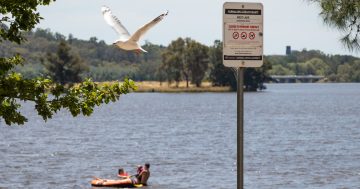
The first splashdown on Lake Burley Griffin in December 2020. Photos: Thomas Lucraft.
A seaplane service on Lake Burley Griffin is a step closer after the National Capital Authority came out in support of the proposal, despite most submissions being opposed.
But the NCA acknowledges the concerns of other lake users and will now hire a consultant to provide guidelines so they and seaplanes can share the waters safely.
The NCA has been talking to lake users and community groups since the Sydney Seaplanes demonstration flight a year ago, and has now published its report.
“This work resulted in the NCA concluding that, subject to all operational, safety, infrastructure issues and commercial matters being appropriately addressed and formalised, it will support the introduction of seaplane operations on the lake,” the report says.
“To advance this decision, the NCA wishes to work with the community and seaplane operators to achieve this outcome.”
The NCA says a working group will begin developing guidelines for shared use of the lake in February 2022.
Sydney Seaplanes has proposed four daily services between Rose Bay and Canberra, two of which would land on and take off from the lake, tying up at the dock near the National Museum of Australia.
The test flight involved a 12-sear Cessna Caravan, but the company intends to use the bigger two-engine amphibious Twin Otter that can carry a maximum of 14 passengers.
South Coast Seaplanes is also interested in lake flights, first offering short scenic flights around Canberra, using single-engine Maule aircraft, but is looking to introduce packaged products, mainly targeted at international tourists, including direct connections with tourist attractions on the South Coast and in the Snowy Mountains.
The NCA received 107 submissions in response to its seaplanes Discussion Paper, from lake-based sporting clubs such as Dragon Boat ACT, Rowing ACT, Black Mountain Rowing Club, Canberra Yacht Club, ANU Sailing Club, YMCA Sailing Club, Canberra Grammar School, community groups such as the Lake Burley Griffin Guardians, Yarralumla Residents Association, Canberra Ornithologists Group, tourism and business entities, and members of the public.

The Cessna Caravan tied up at the Yarralumla Bay dock.
Of the submissions, 72 did not support the proposal, 21 did, eight were neutral or mixed, and six were undecided and needed more information.
The NCA noted Riotact polling on the issue which found respondents were close to evenly divided on the issue, with supporters slightly ahead.
To the question, ‘Should we allow seaplanes to land on Lake Burley Griffin?’, the poll received a total of 833 responses – No, let’s keep the lake peaceful and quiet – 408 votes (49%), and Yes, it’s a fun idea that will enliven the lake – 425 votes (51%).
The NCA found that seaplane operations would enrich the appreciation of Canberra as the national capital and contribute to a diversification of the local economy, but further work was required to address the concerns of existing lake users.
Interestingly, Sydney Seaplanes plans to convert to electric seaplanes by 2025, which could allay some of the environmental and noise concerns.
“The NCA is of the view that the potential impacts of seaplane operations on Lake Burley Griffin can be appropriately managed and that there are significant benefits in creating a unique travel tourism link to the nation’s capital,” the NCA says.
“Of critical note is how to address the potential conflicts between seaplanes and other lake users (both current and potential future users).”
Issues raised in the submissions ranged from safety, environmental and noise concerns to a precedent opening up the lake to more powered boats.
But lake businesses, the National Museum of Australia, where the seaplane would moor, the Canberra Region Tourism Leaders Forum and Chief Minister and Tourism Minister Andrew Barr backed the proposal, welcoming greater activation of the lake and believing that it would boost the local economy by providing opportunities to showcase the city and region.




















